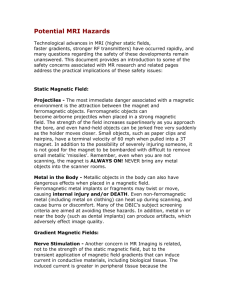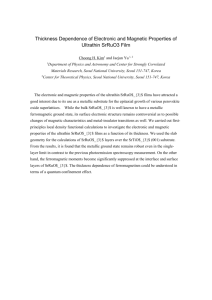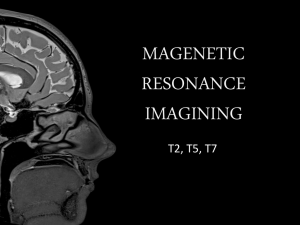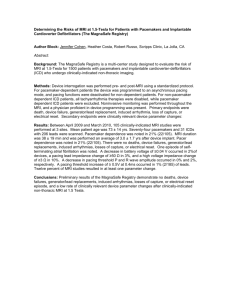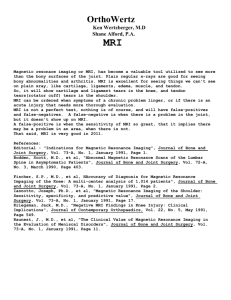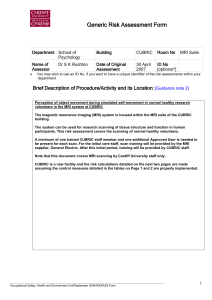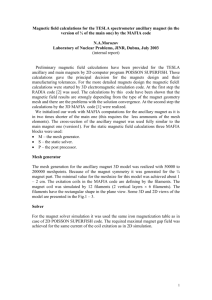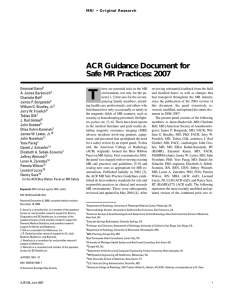MRI and Critically Ill Patients - Wellington Intensive Care Unit
advertisement
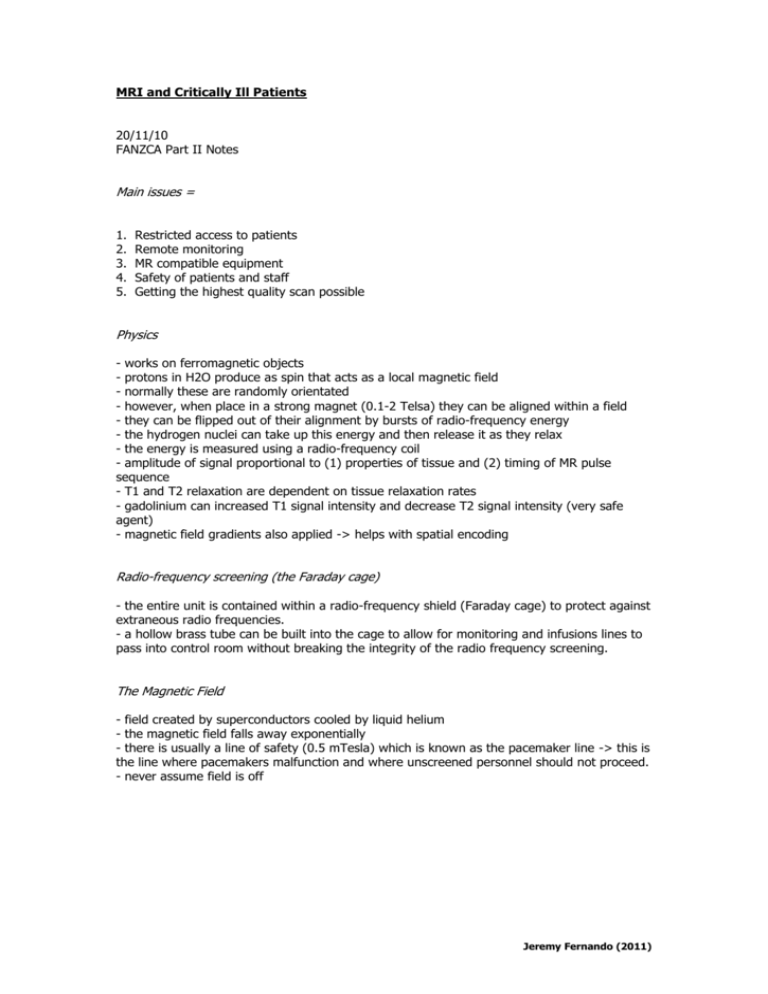
MRI and Critically Ill Patients 20/11/10 FANZCA Part II Notes Main issues = 1. 2. 3. 4. 5. Restricted access to patients Remote monitoring MR compatible equipment Safety of patients and staff Getting the highest quality scan possible Physics - works on ferromagnetic objects - protons in H2O produce as spin that acts as a local magnetic field - normally these are randomly orientated - however, when place in a strong magnet (0.1-2 Telsa) they can be aligned within a field - they can be flipped out of their alignment by bursts of radio-frequency energy - the hydrogen nuclei can take up this energy and then release it as they relax - the energy is measured using a radio-frequency coil - amplitude of signal proportional to (1) properties of tissue and (2) timing of MR pulse sequence - T1 and T2 relaxation are dependent on tissue relaxation rates - gadolinium can increased T1 signal intensity and decrease T2 signal intensity (very safe agent) - magnetic field gradients also applied -> helps with spatial encoding Radio-frequency screening (the Faraday cage) - the entire unit is contained within a radio-frequency shield (Faraday cage) to protect against extraneous radio frequencies. - a hollow brass tube can be built into the cage to allow for monitoring and infusions lines to pass into control room without breaking the integrity of the radio frequency screening. The Magnetic Field - field created by superconductors cooled by liquid helium - the magnetic field falls away exponentially - there is usually a line of safety (0.5 mTesla) which is known as the pacemaker line -> this is the line where pacemakers malfunction and where unscreened personnel should not proceed. - never assume field is off Jeremy Fernando (2011) Safety PATIENT - absolute contraindications – cochlear implants, pacemakers and ICD’s, intraocular metallic F/B, ferromagnetic neurovascular surgical clips - surgical clips, joint prostheses, artificial heart valves and sternal wires are safe as they are fixed by fibrous tissue and magnetic field is insignificant - xrays can be used to search for metallic foreign objects - need ear protection STAFF - same precautions apply to staff - pregnant staff should not work in MRI (particularly first trimester) - if magnet shut down in an emergency (quenching) -> helium can be released inducing hypoxia Magnetic specific environment - absolute contraindications – cochlear implants, pacemakers, ICD, metallic eye F/B, ferromagnetic neurosurgical clips (included for staff and patients) - relative contraindications – other metal objects in the body (need to be discussed with radiologist) - ferromagnetic equipment – if machine to be inside MRI room -> must be MR compatible -> otherwise objects can become projectile - noise – ear protection - burns – monitoring has caused burns to patients (must be fiberoptic or carbon fibre cabling) - quenching magnet – emergency shut down of magnet -> helium released and causes dramatic fall in FiO2 -> hypoxaemia Procedure - problems = duration long + requires immobility - personnel – anaesthesia should be carried out by an Anaesthetist or a adequately experienced and supervised trainee + an adequately trained assistant + personnel for positioning patient - assessment – an adequate assessment of the patient must be performed which includes; indications for anaesthesia, chart review and full medical history and focussed examination, type of anaesthetic, plan for recovery and discussion of risks and benefits - airway completely inaccessible - need plastic connectors - maintenance with IV or volatiles (infusion pumps are strongly ferromagnetic) - MRI compatible machines and ventilators available now OR machines and ventilators outside magnetic field - anaesthetist need to familiar with the way a patient can be rapidly removed from the scanner and assessed. - measured airway pressures may not be accurate (may be reading pressure from end of ETT) - delivered TV will be less than measured because of ‘compression losses’ of gases within system and expansion of tubing during inspiration - tape ETT pilot balloon (with ferromagnetic spring) away from site being imaged - minimise infusions - theoretic risk of microshock with CVL, PA catheters or pacing wires -> remove wires Jeremy Fernando (2011) - remove pacemakers, bolts, conventional ECG leads Monitoring - all equipment needs to be MR compatible (non-ferromagnetic) - all monitoring should be placed in control room outside of the magnet environment - use of fibre-optic or carbon fibre cabling (expensive, fragile but don’t effect image) - visual alarms because of noise from MRI - ECG - can look like hyperkalaemia (Farradays law) + subject to interference -> use braided, short MRI compatible leads placed in a narrow triangle on chest - ETCO2 -> because of length of tubing 20 second delay. SUMMARY OF RISKS General – magnetic field induced movement of ferromagnetic objects - ferrous projectiles accelerating into scanner causing trauma movement of ferrous implants and prostheses movement of metallic foreign bodies (foreign bodies in the eyes) others: malfunction/failure or pacemaker/IAD Specific - cold environment - prolonged exposure time away from ICU due to length of time it takes to do MRI - patient inaccessibility - monitoring and ventilation equipment limited (must be MRI compatible) - unable to take resuscitation equipment into the ‘magnet zone’ - infusions may be difficult to run – MRI compatible pumps that can be used in ‘magnet zone’ and not widely available -> long tubing must be used - gadolinium exacerbation of nephrogenic systemic fibrosis - risk of hyperthermia in patients with disordered thermal regulation - potential for burns (ECG dots) Jeremy Fernando (2011)
